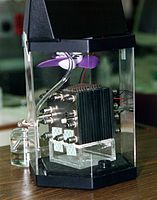
Photo from wikipedia
Direct electron transfer at microbial anodes offers high energy conversion efficiency but relies on low concentrations of redox centers on bacterium membranes resulting in low power density. Here a heat-treatment… Click to show full abstract
Direct electron transfer at microbial anodes offers high energy conversion efficiency but relies on low concentrations of redox centers on bacterium membranes resulting in low power density. Here a heat-treatment is used to delicately tune nitrogen-doping for atomic matching with Flavin (a diffusive mediator) reaction sites resulting in strong adsorption and conversion of diffusive mediators to anchored redox centers. This impregnates highly concentrated fixed redox centers in the microbes-loaded biofilm electrode. This atomic matching enables short electron transfer pathways resulting in fast, direct electrochemistry as shown in Shewanella putrefaciens ( S. putrefaciens ) based microbial fuel cells (MFCs), showing a maximum power output higher than the conventional non-matched nitrogen-doped anode based MFCs by 21 times. This work sheds a light on diffusion mediation for fast direct electrochemistry, while holding promise for efficient and high power MFCs. In microbial fuel cells direct electron transfer offers high energy conversion efficiency, but low concentrations of redox centers on bacterial membranes result in low power density. Here nitrogen-doping is fine tuned to match Flavin reaction sites, converting diffusive mediators to anchored redox centers toward direct electrochemistry.
Journal Title: Communications Chemistry
Year Published: 2020
Link to full text (if available)
Share on Social Media: Sign Up to like & get
recommendations!